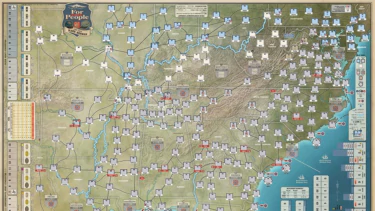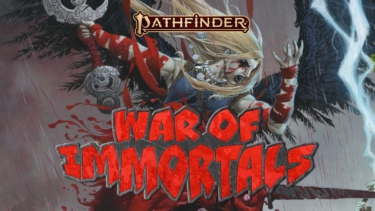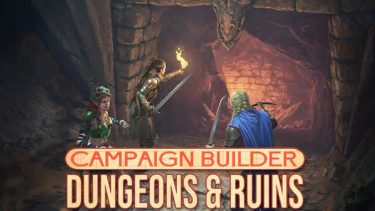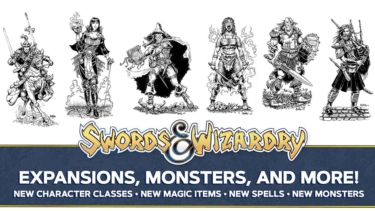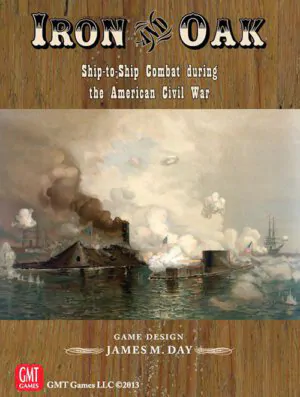
Publisher: GMT Games
Designer: James M. Day
Artists: Charles Kibler, Rodger B. MacGowan, and Louis Prang
Year: 2013
Genre: Tactical American Civil War naval wargame
Players: Two or more players
Ages: 13+
Playing Time: 60 to 90 minutes
MSRP: $59.00
Very rarely do I come across a GMT title which leaves me disappointed. Sure there’s been a release or two which weren’t necessarily up my alley but I could certainly see where the specific audience for those games would really dig them; I make mention all the time I consider myself a wargamer but not really a grognard as massive 30+ hour games, taking place across hex strewn maps with thousands of counters, just aren’t my bag anymore. On the other hand, I still love to spend an entire Saturday or Sunday playing a single epic game with friends. I make mention of these things not because Iron & Oak is a bad game (or I was overly disappointed with it) but one which will appeal to a particular audience which I may not be a part. Not to say you’ll invest anywhere near that amount of time with Iron & Oak but it just may be I’m not the intended audience for the game.
Iron & Oak is a fast playing game of tactical naval combat during the American Civil War pitting Union and Confederate wooden ships and ironclads against one another. Most battles will play out in sixty to ninety minutes on average leaving plenty of time to fit in a short campaign in an afternoon. The rules aren’t overly complex and you should be able to get to your first battle within a half hour or so when teaching the game.
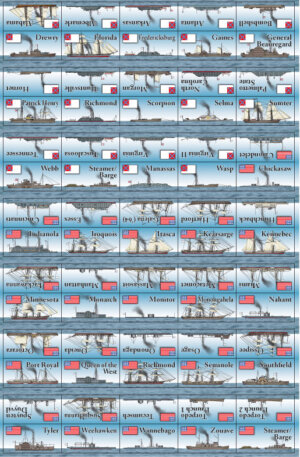
I have the impression the rulebook wasn’t vetted to the normal GMT standards because the company wanted to get Iron & Oak out at the same time as Rebel Raiders on the High Seas. It’s understandable since both titles can tie together as Rebels naval battles can be gamed with Iron & Oak.
One item in the presentation, which is a major head scratcher, is the decision to utilize a side view of the vessels on the counters. Really I haven’t a clue why to go in this direction since a top down view would have been not only much more attractive on the gaming table but make actual gameplay a bit cleaner. The only possible reason I could see for the side view is possibly the top down would have required larger counters.
Each side sets up depending on the scenario chosen by selecting their ships and the Order decks for each ship. Then Action cards are drawn for the Union and Confederates (once again depending on the scenario) which will be available during the fight. While the Action cards enhance the game they don’t drive the game; the cards you draw are what you’ll have for the battle although you can exchange a card you aren’t drawing new hands of Action cards throughout the game. Once set up is complete you’re ready to start.
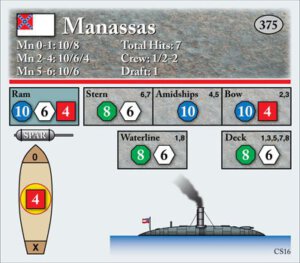
Status Phase – Repair attempts are resolved as well as checks on fires aboard ships on in forts. New repair crews can be assigned at this time too.
Order Phase – Each vessel on the side reveals the order card which was placed next to their data card. These can be Anchor or Weigh Anchor, Refloat (if grounded), Unfoul (if fouled), Drift, or Maneuver. I’m not sure why Order cards are even used since it isn’t as if the players are alternating movement and most of the cards are devoted to actions which could easily be marked with a counter.
Action Phase – The active player reveals the Orders for each of his ships and resolves them in any sequence. Movement across the grid map is made in relation to other ships in the battle as opposed to point to point. In changing the disposition of vessels each player rolls dice compared to a maneuver chart in order to move into position to pull off such things as “crossing the T” or ramming. Movement action cards are played at this time as well if the player wishes. This is the weakest part of the design as much of the jockeying for position is all up to the roll of the dice (or play of a card) as opposed to utilizing solid tactics. Plus this seems to over complicate the matters.
Once movement is complete the active player conducts gunnery attacks. Each vessel is rated for gunnery with different dice. For example you may have a d10 and a d8 rating. You’ll roll both dice and take the higher roll while also rolling a d8 for the hit location. Once that’s done the target player rolls the dice for the defense of that location and takes the highest roll as well. The attacker’s number is compared to the defender’s to see if damage is dealt and to what extent. Of course modifiers to both rolls come into play and there’s plenty of ways to blast your opponent including critical hits. During this period of the Action Phase is where the gunnery Action cards are used.
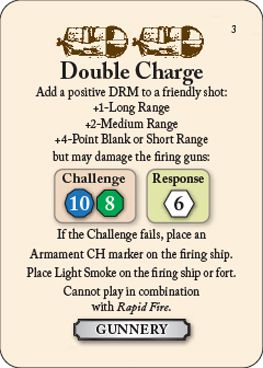
After the first player (or team) completes the Status, Order, and Action Phases the other side completes these phases as well. Once the Union and Confederates are finished the Victory Phase is completed to see if either side has won the scenario. Normally this consists of sinking a percentage of the enemy vessels. If neither side has won it’s on to the next turn.
Along with the rulebook GMT has included one of their patented play books which includes eleven scenarios, campaign rules, a scenario generator, designer notes and more. I always like these play books and they go a long way toward not only understanding any given title but also my enjoyment as well.
Speaking of enjoyment, I’m really a bit on the fence about Iron & Oak. I dig the gunnery aspect of the design and it really gives one the sense of a solid naval miniatures foundation; I wouldn’t be surprised if this portion of the design evolved from a miniatures design. What I’m not overly keen on is the movement and maneuvering. Movement isn’t overly intuitive and the fact a grid is used – where everything is in relation to other ships – takes away the feeling one is playing a naval game. I’m not alone in my assessment as the people I played Iron & Oak with felt the way I do; they thought the gunnery was really interesting but moving around the grid didn’t seem like a natural fit and the rolling of dice to see if you can move how you’d like added some frustration for a couple players.
I have to say as someone who considers the American Civil War to be a period of history I’m pretty well versed with, a tactical naval board game might be tough to pull off. Ironclads can normally easily dispatch wooden ships while ironclads teeing off against each other ended more times than not at a stalemate. Especially when the design of the Union ironclads made them extremely hard to score solid hits – let alone penetrate their armor – historically the only loses were due to weather and not enemy cannon fire. Strangely enough the Union ironclads in Iron & Oak are much easier damaged than their historic counterparts.
Iron & Oak is fairly fun, and I’d rather not dissuade anyone from giving the title a try, yet I find the game plays a little too loose with the historical data and is abstract in too much of the movement aspects to be considered a solid tactical simulation. Add to this some of the oddities of the design, presentation, and production (as well as not getting a strong naval feel for the proceedings) puts this in a category of decent game but not one of my GMT must plays. I suppose this makes Iron & Oak a disappointment but at least not a horrible one.
- Paizo Preview April 2024 - Apr 19, 2024
- Broken Weave for 5E is Out in PDF - Apr 19, 2024
- Score Big Savings with the Ars Magica 5E Bundle of Holding - Apr 19, 2024




